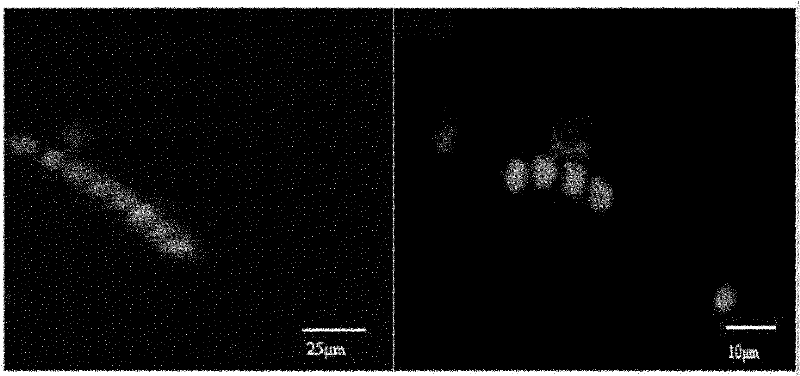Detection method of symbiotic bacteria in sponge cell based on quantum dot fluorescence in-situ hybridization
A technology of fluorescence in situ hybridization and symbiotic bacteria, applied in biochemical equipment and methods, fluorescence/phosphorescence, microbial measurement/inspection, etc., can solve the problems of difficult antigen-antibody reactions, low antigenicity, and complex components. Achieve the effect of avoiding the interference of autofluorescence
- Summary
- Abstract
- Description
- Claims
- Application Information
AI Technical Summary
Problems solved by technology
Method used
Image
Examples
Embodiment 1
[0029] The specific implementation steps of this embodiment are as follows:
[0030] 1. Separation of sponge cells:
[0031] (1) The following operations are all performed under aseptic conditions. Sponge tissue (1-2g) is thawed at 4℃ and cut into less than 0.5cm 3 Of small pieces. Add 15-20 times the volume of artificial seawater (1.1g CaCl 2 , 10.2g MgCl 2 ·6H 2 O, 31.6g NaCl, 0.75gKCl, 1.0g Na 2 SO 4 , 2.4g Tris / HCl, 0.02g NaHCO 3 , 1L deionized water, pH 7.6) in an Erlenmeyer flask, 110rpm, 20℃, gentle shaking for 40min-60min.
[0032] (2) The sponge pieces washed in the previous step are gently rubbed on a 200-mesh stainless steel cell sieve to mechanically dissociate, so that the sponge pieces become pureed, and at the same time use 20-25 times the volume of calcium and magnesium-free artificial seawater ( 31.6g NaCl, 0.75g KCl, 1.0gNa 2 SO 4 , 2.4g Tris / HCl, 0.02g NaHCO 3 , 7.2g EDTA, 1L deionized water, pH 7.6) rinse, transfer to an Erlenmeyer flask 110rpm, 20°C shaking, di...
Embodiment 2
[0040] The specific implementation steps of this embodiment are as follows:
[0041] 1. Separation of sponge cells:
[0042] (1) The following operations are all performed under aseptic conditions. Sponge tissue (1-2g) is thawed at 4℃ and cut into less than 0.5cm 3 Of small pieces. Add 15-20 times the volume of artificial seawater (1.1g CaCl 2 , 10.2g MgCl 2 ·6H 2 O, 31.6g NaCl, 0.75gKCl, 1.0g Na 2 SO 4 , 2.4g Tris / HCl, 0.02g NaHCO 3 , 1L deionized water, pH 7.6) in an Erlenmeyer flask, 110rpm, 20℃, gentle shaking for 40min-60min.
[0043] (2) The sponge pieces washed in the previous step are gently rubbed on a 200-mesh stainless steel cell sieve to mechanically dissociate, so that the sponge pieces become pureed, and at the same time use 20-25 times the volume of calcium and magnesium-free artificial seawater ( 31.6g NaCl, 0.75g KCl, 1.0gNa 2 SO 4 , 2.4g Tris / HCl, 0.02g NaHCO 3 , 7.2g EDTA, 1L deionized water, pH 7.6) rinse, transfer to an Erlenmeyer flask 110rpm, 20°C shaking, di...
Embodiment 3
[0051] The specific implementation steps of this embodiment are as follows:
[0052] 1. Separation of sponge cells:
[0053] (1) The following operations are all performed under aseptic conditions. Sponge tissue (1-2g) is thawed at 4℃ and cut into less than 0.5cm 3 Of small pieces. Add 15-20 times the volume of artificial seawater (1.1g CaCl 2 , 10.2g MgCl 2 ·6H 2 O, 31.6g NaCl, 0.75gKCl, 1.0g Na 2 SO 4 , 2.4g Tris / HCl, 0.02g NaHCO 3 , 1L deionized water, pH 7.6) in an Erlenmeyer flask, 110rpm, 20℃, gentle shaking for 40min-60min.
[0054] (2) The sponge pieces washed in the previous step are gently rubbed on a 200-mesh stainless steel cell sieve to mechanically dissociate, so that the sponge pieces become pureed, and at the same time use 20-25 times the volume of calcium and magnesium-free artificial seawater ( 31.6g NaCl, 0.75g KCl, 1.0gNa 2 SO 4 , 2.4g Tris / HCl, 0.02g NaHCO 3 , 7.2g EDTA, 1L deionized water, pH 7.6) rinse, transfer to an Erlenmeyer flask 110rpm, 20°C shaking, di...
PUM
 Login to View More
Login to View More Abstract
Description
Claims
Application Information
 Login to View More
Login to View More - R&D
- Intellectual Property
- Life Sciences
- Materials
- Tech Scout
- Unparalleled Data Quality
- Higher Quality Content
- 60% Fewer Hallucinations
Browse by: Latest US Patents, China's latest patents, Technical Efficacy Thesaurus, Application Domain, Technology Topic, Popular Technical Reports.
© 2025 PatSnap. All rights reserved.Legal|Privacy policy|Modern Slavery Act Transparency Statement|Sitemap|About US| Contact US: help@patsnap.com


